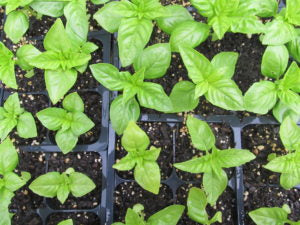 This variety is a great example of how food culture has influenced plant breeding over hundreds of years. Pesto is a regional dish from Genoa in the Liguria region of northern Italy. Over time, Genovese villagers selected this basil for the qualities they felt made the best pesto: large thick leaves, sturdy plants that withstand multiple harvests, and deep green leaves that retain their color when crushed.
This variety is a great example of how food culture has influenced plant breeding over hundreds of years. Pesto is a regional dish from Genoa in the Liguria region of northern Italy. Over time, Genovese villagers selected this basil for the qualities they felt made the best pesto: large thick leaves, sturdy plants that withstand multiple harvests, and deep green leaves that retain their color when crushed.
Genovese Basil may not be the showiest of plants to look at, but flavor-wise, it is extremely showy, vibrant and colorful. And this is one of the reasons why Hazel Jarvis, artist and mapmaker, is such a perfect fit for this variety. We love how she uses different papers and textures to bring out the cultural and culinary traditions that stand behind basil. Hazel draws our attention first and foremost to the vibrancy of the basil leaves, but she also allows us to see and experience all of this plant's many nuances.
Hazel, how did you start making art? I trained first as an art historian and then as a Botanical illustrator originally. Since then my interests have expanded to include calligraphy, collage and map making. I hope that people will learn to look more closely and see amazing colors and patterns in nature.
 Hazel in the studio working on the collage.
Hazel in the studio working on the collage.Can you tell us a bit about your artistic medium and process? I use a combination of media - paint, ( watercolor, gouache and acrylics.) I love paper and haunt flea markets in search of letters, old maps, stamps and paper ephemera.
I start by drawing and then painting my subject. The collage is the fun part. Sometimes I use paper I have found or I use old calligraphy practice sheets which I glaze with thin acrylic color and often I make painted paper - painting and then stamping or stenciling on printer paper.
For this piece, I chose to include snippets from an old map of Italy to enhance the Italian theme. Look very closely and you can see Tuscany and Rome in the leaves. The map of Genoa is a very loose and free hand version of an old map of Genoa created around 1490. I chose it because I wanted to convey an idealized image of the Italian city and countryside. I drew it in pale sepia ink so that it would not compete with the focus on the basil. I wanted to convey the rich culinary and cultural traditions behind Basil, a favorite herb in Italian cuisine.

(Above: Collection of paper for the collage, including calligraphy practice sheets, Italian marbled paper, old map, Japanese paper and hand painted paper plus Basil from the garden.)
What are your favorite elements of this artwork and can you tell us more about the calligraphy on the mortar?
I love the greens. I love the energy of the Basil plant. The Calligraphy on the mortar is from an old scrap of wrapping paper. I used it because it’s in Italian. I think of the calligraphy on the leaves as referencing veins.
See more of Hazel's work at www.hazeljarvis.com. Follow her on Instagram @hazeljarvisstudio.
How to Grow Genovese Basil
 Days to Germination 4-10 days
Days to Germination 4-10 days
Days to Maturity 65 days
Planting Depth 1/4 inch
Spacing in Row 18 inches
Spacing Between Rows 12 inches
Height at Maturity 12 to 24 inches
Width at Maturity 12 inches
Direct sow after frost, or start indoors up to 1 month before last frost date. For young, tender basil plants, space 2" apart; for bigger, heartier plants space 8-12" apart. To have fresh basil the whole season, start in succession at one-month intervals. Pinch off tallest growth in order to keep basil from flowering; flavor becomes too strong once in bloom. Good for garden or container plantings.
Other Basils to Tempt Your Taste Buds






